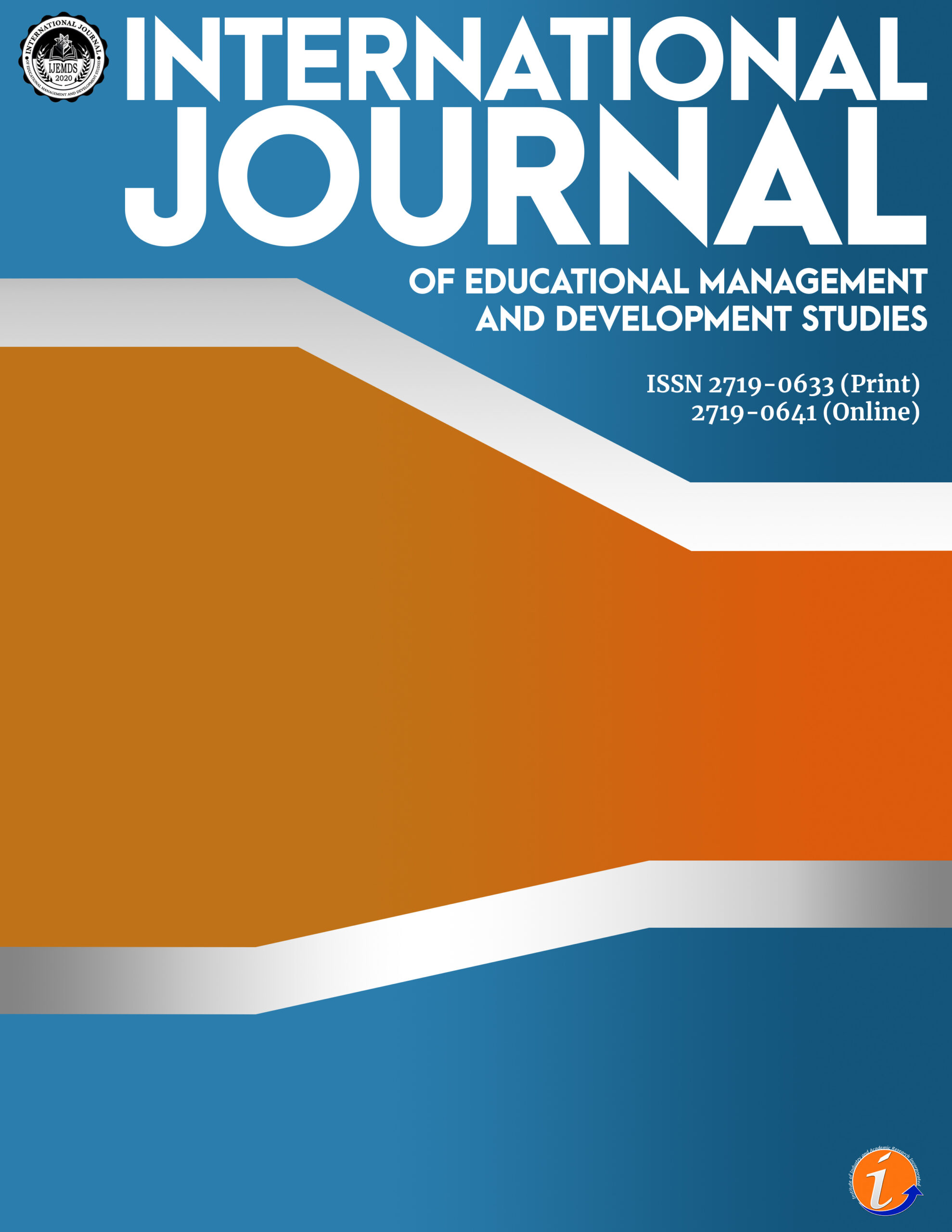Naturally, students are afraid to learn Mathematics that progresses as a fear of getting things wrong. This study utilizes the descriptive-correlational research design to test how the math anxiety and mathematics are connected to each other. Forty-two (42) Grade 7 students participated in the study during the school year 2020-2021. It used a researcher-made survey questionnaire on math anxiety and an examination on mathematical representations through modular learning. The math anxiety is indicated by mathematics test anxiety and numerical anxiety both with ten statements. Meanwhile, the examination was focused on the different components of mathematical representation such as pictures, manipulative models, written symbols, real-world situations and oral language. The result showed that students have high level of anxiety towards mathematics. Although students experience high level of test and numerical anxiety, their mathematical representations examination showed ‘developing’ level of performance. These two inverse results were supported by a no significant relationship between the math anxiety and students’ performance in mathematics. Although the inverse relationship proved the effect of the anxiety on the test scores, the null hypothesis on the relationship of the variables was rejected. The study recommends further testing involving different modalities of learning such as online and hybrid.
grade 7 students, math anxiety, mathematical representations, representations
Yno Ferdinand D. Escarez Jr. Corresponding author. BSEd- Mathematics Student, Laguna State Polytechnic University- San Pablo City Campus
Delon A. Ching. Research Advisor. Instructor I, Laguna State Polytechnic University- San Pablo City Campus
This paper is a finalist in the IIARI Research Competition (IRC) – 2021 Category 2 – Undergraduate
Appiah Essuman, S., Nyarko, J. ., & Frimpong, K. . (2021). Impact of Mathematics Anxiety on the Academic Performance of Junior High School Pupils in the Bongo District of Ghana Stanley Appiah Essuman, Josephine Nyarko, Kwarteng Frimpong. International Journal of Social Sciences and Humanities Invention, 8(09), 6553–6561. https://doi.org/10.18535/ijsshi/v8i09.05
Azizaa, M. (2017). The use of open-ended question pictures in the mathematics classroom. New Trends and Issues Proceedings on Humanities and Social Sciences, 4(9), 1-9. https://doi.org/10.18844/prosoc.v4i9.3036
Baker, C. (2017). Quantitative research designs: Experimental, quasi-experimental, and descriptive. Evidence-based practice: An integrative approach to research, administration, and practice, 155-183.
Baloğlu M, Zelhart PF. Psychometric properties of the Revised Mathematics Anxiety Rating Scale. Psychol Rec. 2007;57(4):593–611.
Carey E., Hill, F., Devine, A., & Szűcs, D. (2016). The chicken or the egg? The direction of the relationship between mathematics anxiety and mathematics performance. Frontiers in Psychology, 6, 1987. https://doi.org/10.3389/fpsyg.2015.01987
Cavanagh, S. (2007). ‘Math anxiety’ confuses the equation for students. Education Week. 26(24), 12.
Caviola, S., Toffalini, E., Giofrè, D. et al. Math Performance and Academic Anxiety Forms, from Sociodemographic to Cognitive Aspects: a Meta-analysis on 906,311 Participants. Educ Psychol Rev 34, 363–399 (2022). https://doi.org/10.1007/s10648-021-09618-5
Dagaylo-AN, M. B., & Tancinco, N. P. (2016). Mathematics anxiety and the academic performance of the freshmen college students of the naval state university. Int. J. Eng. Sci. Res. Technol, 5, 1125-1136. https://doi.org/10.5281/zenodo.58530
Dowker, A., Sarkar, A., & Looi, C. Y. (2016). Mathematics anxiety: What have we learned in 60 years?. Frontiers in psychology, 7, 508.
Fuchs, L. S., Gilbert, J. K., Fuchs, D., Seethaler, P. M., & N. Martin, B. (2018). Text comprehension and oral language as predictors of word-problem solving: Insights into word-problem solving as a form of text comprehension. Scientific Studies of Reading, 22(2), 152-166. https://doi.org/10.1080/10888438.2017.1398259
Futalan, M. C. Z., & Mamhot, M. R. (2018). Students’ Workload and Mathematical Anxiety under the New DepEd K to 10 Curriculum of the Philippines. Prism, 23(1).
Gresham, G. (2007). A study of mathematics anxiety in pre-service teachers. Early Childhood Education Journal, 35(2), 181-188.
Guita, G. B., & Tan, D. A. (2018). Mathematics anxiety and students’ academic achievement in a reciprocal learning environment. International Journal of English and Education, 7(3), 112-124.
Hua, D. O. N. G., Qiang, W. E. I., Wei-Ran, C. U. I., & Wen-Jing, L. U. (2019). Mathematical Symbols, Learning Experiences and Number Sense: A Study of Three Grades Primary School Students. DEStech Transactions on Economics, Business and Management, (icaem). https://doi.org/10.12783/dtem/icaem2019/31121
Jitendra, A. K., Nelson, G., Pulles, S. M., Kiss, A. J., & Houseworth, J. (2016). Is mathematical representation of problems an evidence-based strategy for students with mathematics difficulties?. Exceptional Children, 83(1), 8-25.https://doi.org/10.1177/0014402915625062
Jolejole-Caube, C., Dumlao, A. B., & Abocejo, F. T. (2019). Anxiety towards mathematics and mathematics performance of grade 7 learners. European Journal of Education Studies.
Kazelskis R. Some dimensions of mathematics anxiety: a factor analysis across instruments. Educ Psychol Meas. 1998;58(4):623–633. [Google Scholar]
Khasawneh, E., Gosling, C. & Williams, B. What impact does maths anxiety have on university students? BMC Psychol 9, 37 (2021). https://doi.org/10.1186/s40359-021-00537-2
Laguen, G. D. (2020, December 23). Filipino students will shine again. Retrieved from The Manila Times: https://www.manilatimes.net/
Lee-Chua, Q. N. (2012, August 26). Even scientists suffer from math anxiety. Retrieved from Philippine Daily Inquirer: https://newsinfo.inquirer.net/258226/even-scientists-suffer-from-math-anxiety
Luttenberger, S., Wimmer, S., & Paechter, M. (2018). Spotlight on math anxiety. Psychology research and behavior management, 11, 311–322. https://doi.org/10.2147/PRBM.S141421
Meke, K. D. P., Jailani, J., Wutsqa, D. U., & Alfi, H. D. (2019, February). Problem based learning using manipulative materials to improve student interest of mathematics learning. In Journal of Physics: Conference Series (Vol. 1157, No. 3, p. 032099). IOP Publishing. https://doi.org/10.1088/1742-6596/1157/3/032099
Mitchell, K. M. (2018). Best practices to reduce math anxiety (Doctoral dissertation, Pepperdine university).
Minarni, A., Napitupulu, E., & Husein, R. (2016). Mathematical understanding and representation ability of public junior high school in North Sumatra. Journal on Mathematics Education, 7(1), 43-56.
Ojose, B. (2011). Mathematics literacy: Are we able to put the mathematics we learn into everyday use. Journal of mathematics education, 4(1), 89-100.
Oxford Learning (2017, February 13). What is Math Anxiety? The Causes and How to Overcome It. Retrieved from Oxford Learning: https://www.oxfordlearning.com/what-is-math-anxiety/
Puteh, M., & Khalin, S. Z. (2016). Mathematics anxiety and its relationship with the achievement of secondary students in Malaysia. International Journal of Social Science and Humanity, 6(2), 119.. https://doi.org/10.7763/IJSSH.2016.V6.630
Rahmawati, D., Hidayanto, E., & Anwar, R. B. (2017). Process of mathematical representation translation from verbal into graphic. International Electronic Journal of Mathematics Education, 12(3), 367-381. https://www.iejme.com/article/process-of-mathematical-representation-translation-from-verbal-into-graphic
Ramirez, G., Hooper, S. Y., Kersting, N. B., Ferguson, R., & Yeager, D. (2018). Teacher math anxiety relates to adolescent students’ math achievement. Aera Open, 4(1), 2332858418756052.
Ramirez, G., Shaw, S. T., & Maloney, E. A. (2018). Math anxiety: Past research, promising interventions, and a new interpretation framework. Educational Psychologist, 53(3), 145-164. https://doi.org/10.1080/00461520.2018.1447384
Reyes, M. D., & Castillo, A. C. (2015). Test anxiety and college students’ performance on mathematics departmental examination: basis for mathematics achievement enhancement. Asia Pacific Journal of Education, Arts and Sciences, 2(1), 62-69.
Ruff, S. E., & Boes, S. R. (2014). The Sum of All Fears: The Effects of Math Anxiety on Math Achievement in Fifth Grade Students and the Implications for School Counselors. Georgia School Counselors Association Journal, 21(1), n1.
Santos, M. L. K. P., Belecina, R. R., & Diaz, R. V. (2015). Mathematical modeling: effects on problem solving performance and math anxiety of students. International Letters of Social and Humanistic Sciences, 65, 103-115.
Selvianiresa, D., & Jupri, A. (2017, February). Analysis of Students’ Incorrect Answers on the Topic of Roman Numerals in The Fourth-Grade of Primary School. In Journal of Physics: Conference Series (Vol. 812, No. 1, p. 012050). IOP Publishing. https://doi.org/10.1088/1742-6596/812/1/012050
Seng, E. L. K. (2015). The Influence of Pre-University Students’ Mathematics Test Anxiety and Numerical Anxiety on Mathematics Achievement. International Education Studies, 8(11), 162-168. https://doi.org/10.5539/ies.v8n11p162
Siregar, H. N. I. (2019) Analysis of students’mathematical representation ability by using problem-based learning in Class VIII-U SMP Negeri 1 Lubuk Pakam.
Skagerlund, K., Östergren, R., Västfjäll, D., & Träff, U. (2019). How does mathematics anxiety impair mathematical abilities? Investigating the link between math anxiety, working memory, and number processing. PloS one, 14(1), e0211283.
Smith, M., Bill, V., & Raith, M. L. (2018). Promoting a conceptual understanding of mathematics. Mathematics Teaching in the Middle School, 24(1), 36-43.
Sokolowski, H. M., & Ansari, D. (2017). Who is afraid of math? What is math anxiety? And what can you do about it. Frontiers for Young Minds, 5(57), 1-7.https://doi.org/10.3389/frym.2017.00057
Sullivan, B. W. (2013). Everything You Always Wanted To Know About Mathematics (Doctoral dissertation, Carnegie Mellon University Pittsburgh, PA).
Susilawati, W. (2020, February). Improving students’ mathematical representation ability through challenge-based learning with android applications. In Journal of Physics: Conference Series (Vol. 1467, No. 1, p. 012010). IOP Publishing. https://doi.org/10.1088/1742-6596/1467/1/012010
Trance, N. J. C., Marapo, R. B., & Pornel, J. B. (2012). Students’ visual representation of mathematics. Journal of The Korean Association For Science Education, 32(8), 1318-1332. https://doi.org/10.14697/jkase.2012.32.8.1318
Tucker, K. (2020, December 21). Examples of Real Life Probability. Retrieved from Sciencing: https://sciencing.com/examples-of-real-life-probability-12746354.html
Widada, W., Herawaty, D., & Lubis, A. N. M. T. (2018, September). Realistic mathematics learning based on the ethnomathematics in Bengkulu to improve students’ cognitive level. In Journal of Physics: Conference Series (Vol. 1088, No. 1, p. 012028). IOP Publishing. https://doi.org/10.1088/1742-6596/1088/1/012028
Widakdo, W. A. (2017, September). Mathematical representation ability by using project based learning on the topic of statistics. In Journal of Physics: Conference Series (Vol. 895, No. 1, p. 012055). IOP Publishing. https://doi.org/10.1088/1742-6596/895/1/012055
Wu, D. B., & Chen, T. C. (2004). The developmental stages of representations of right rectangular prisms of elementary school students. In conference of the learning to teach and teaching to learn. Taipei, Taiwan: National Taipei University of Education (in Chinese).
Ziegler, G. M., & Loos, A. (2017). “What is Mathematics?” and why we should ask, where one should experience and learn that, and how to teach it. In Proceedings of the 13th International Congress on Mathematical Education (pp. 63-77). Springer, Cham. https://doi.org/10.1007/978-3-319-62597-3_5
Cite this article:
Escarez, Y.D. & Ching, Delon A. (2022). Math anxiety and mathematical representations of grade 7 students. International Journal of Educational Management and Development Studies, 2(4), 148-162. https://doi.org/10.53378/352868
License:
![]()
This work is licensed under a Creative Commons Attribution (CC BY 4.0) International License.










